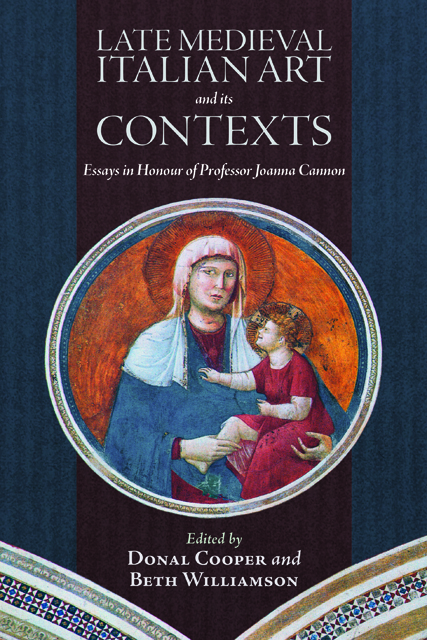Book contents
- Frontmatter
- Contents
- List of Illustrations
- List of Contributors
- Acknowledgements
- List of Abbreviations
- 1 Introduction: Circling Giotto
- 2 Holy Wood / ‘sacra tavola’: Saint Dominic and the Memory of Miracles in Bologna
- 3 The Sculpted Saint: A Statue of Saint Francis in Siena
- 4 Guccio di Mannaia and the Concept of a ‘Franciscan’ Chalice
- 5 ‘Speculum sine macula’: The Trittico di Santa Chiara in Trieste as an Object of Clarissan Devotion
- 6 The Siena Connection: A Franciscan Provincial Minister between Tuscany and Assisi at the Dawn of the Trecento
- 7 Simone Martini’s ‘Treaty with the House of Santa Fiora’ in Siena’s Palazzo Pubblico: Its Date and Significance
- 8 Crisis and Charity in Fourteenth-Century Florence: Ambrogio Lorenzetti’s Saint Nicholas Panels for San Procolo
- 9 Father of Light: Giotto and the Beatific Vision in the Baroncelli Chapel
- 10 Painter-Illuminator Workshops and the Church of San Giorgio a Ruballa: The Case of Bernardo Daddi and Pacino di Bonaguida
- 11 Patterns of Holiness: A Virgin Lactans in a Franciscan Context
- 12 A New Angle on Simone Martini’s Holy Family
- 13 Artistic Appropriation, Institutional Identity, and Civic Religion in Fourteenth-Century Siena: The Byzantine Treasury of the Hospital of Santa Maria della Scala
- 14 Visual Religious Education in Late Medieval Florence: Zanobi Perini, The Leggenda di Santo Tobia, and The Misericordia
- 15 Saints and Status in Late Medieval and Early Renaissance Florence
- Select Bibliography
- Publications by Joanna Cannon
- Index
- Tabula Gratulatoria
- Backmatter
14 - Visual Religious Education in Late Medieval Florence: Zanobi Perini, The Leggenda di Santo Tobia, and The Misericordia
Published online by Cambridge University Press: 20 December 2022
- Frontmatter
- Contents
- List of Illustrations
- List of Contributors
- Acknowledgements
- List of Abbreviations
- 1 Introduction: Circling Giotto
- 2 Holy Wood / ‘sacra tavola’: Saint Dominic and the Memory of Miracles in Bologna
- 3 The Sculpted Saint: A Statue of Saint Francis in Siena
- 4 Guccio di Mannaia and the Concept of a ‘Franciscan’ Chalice
- 5 ‘Speculum sine macula’: The Trittico di Santa Chiara in Trieste as an Object of Clarissan Devotion
- 6 The Siena Connection: A Franciscan Provincial Minister between Tuscany and Assisi at the Dawn of the Trecento
- 7 Simone Martini’s ‘Treaty with the House of Santa Fiora’ in Siena’s Palazzo Pubblico: Its Date and Significance
- 8 Crisis and Charity in Fourteenth-Century Florence: Ambrogio Lorenzetti’s Saint Nicholas Panels for San Procolo
- 9 Father of Light: Giotto and the Beatific Vision in the Baroncelli Chapel
- 10 Painter-Illuminator Workshops and the Church of San Giorgio a Ruballa: The Case of Bernardo Daddi and Pacino di Bonaguida
- 11 Patterns of Holiness: A Virgin Lactans in a Franciscan Context
- 12 A New Angle on Simone Martini’s Holy Family
- 13 Artistic Appropriation, Institutional Identity, and Civic Religion in Fourteenth-Century Siena: The Byzantine Treasury of the Hospital of Santa Maria della Scala
- 14 Visual Religious Education in Late Medieval Florence: Zanobi Perini, The Leggenda di Santo Tobia, and The Misericordia
- 15 Saints and Status in Late Medieval and Early Renaissance Florence
- Select Bibliography
- Publications by Joanna Cannon
- Index
- Tabula Gratulatoria
- Backmatter
Summary
The work of Joanna Cannon has considerably enriched our understanding of the varied functions of religious images in late medieval Italy. My contribution to her Festschrift intersects with her work, as I explore the multi-layered relationship between visual hagiography and lay religious education (something she did masterfully in her inspirational study on Margherita of Cortona). This chapter is about two illustrations in a manuscript of the Leggenda di Santo Tobia (a vernacular version of the Book of Tobit) copied and illustrated in 1408 by a Florentine youth, Zanobi di Pagolo di Agnolo Perini, for his own edification (Plate XXI, Fig. 14.3). The manuscript is bound into a miscellany, Florence, Biblioteca Nazionale Centrale di Firenze, Fondo Nazionale MS II.II.445 (hereafter BNCF II.II.445), which contains other texts copied by Zanobi in the years 1407–9, as well as his own illustrations (Figs. 14.1, 14.2, 14.3, Plate XX), in addition to those executed by another illustrator (Plate XXI). This is not the only such example of a miscellany produced by a teenager that has come down to us; Florence, Biblioteca Riccardiana MS 1655 was copied and illustrated in 1399 by Romigi d’Ardingo di Corso de’ Ricci when he was sixteen or seventeen years old.
The illustrations in these miscellanies have received virtually no scholarly attention. Yet they are very important testimonies; they formed part of a vast corpus of images, of which very little survives, created by individuals with no artistic training, and shared by the majority of people living in urban centres. In the case of Zanobi’s miscellany, as I shall demonstrate, it bears witness to the attitude of a youth to well-known works of art. More importantly, the illustrations of the Leggenda contribute to our understanding of how visual hagiography was employed in the religious education of the young. The images appear to have been inspired by the Story of Tobit and Tobias, a fresco cycle painted c. 1350–70 in the domus residentiae of the compagnia of Santa Maria della Misericordia. According to documentary evidence, this confraternity took care of abandoned children; I shall propose in this essay that the fresco, like the text of the Leggenda, served to provide the young charges of the Misericordia with religious and moral instruction.
- Type
- Chapter
- Information
- Late Medieval Italian Art and its ContextsEssays in Honour of Professor Joanna Cannon, pp. 271 - 288Publisher: Boydell & BrewerPrint publication year: 2022



